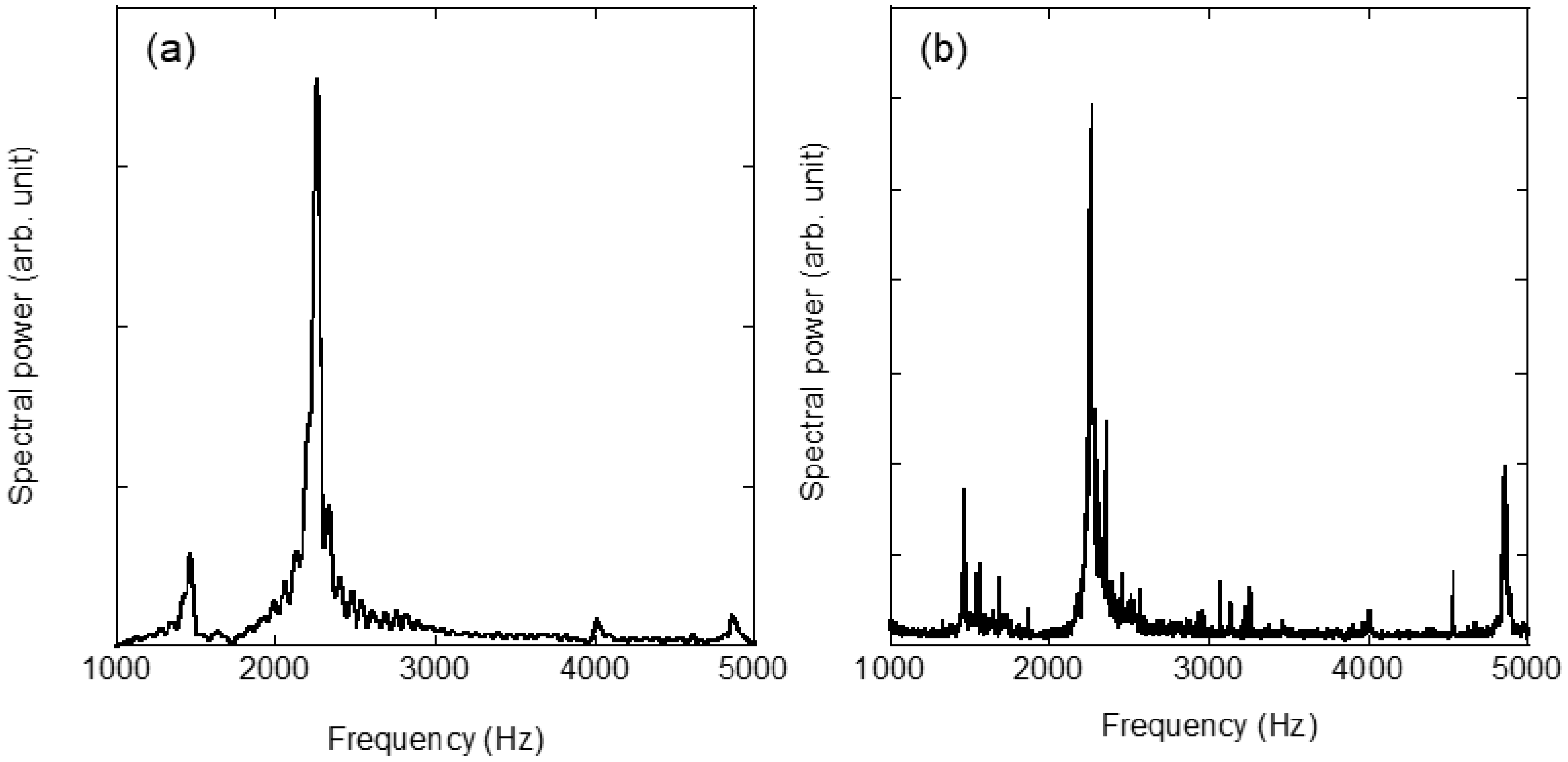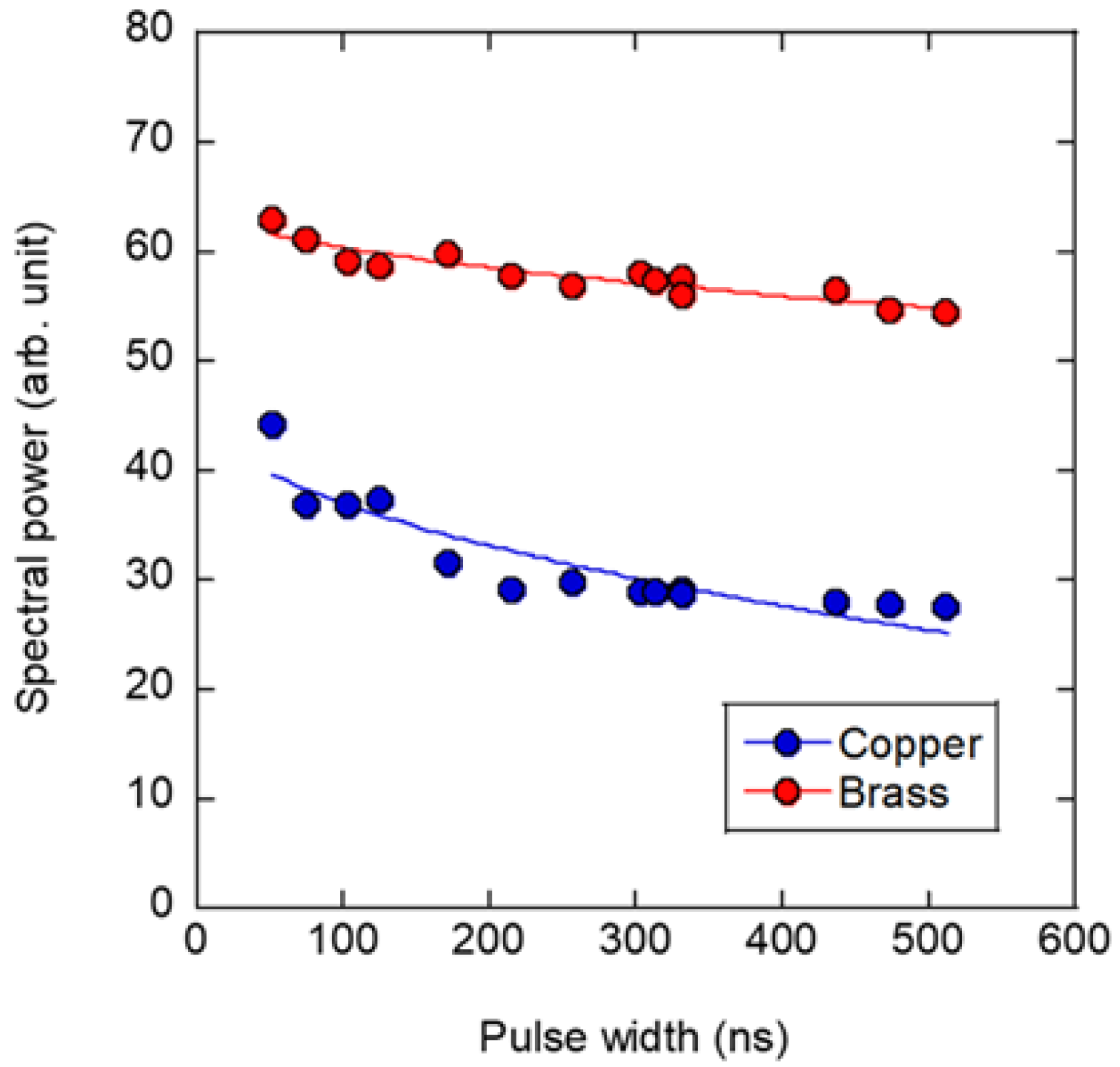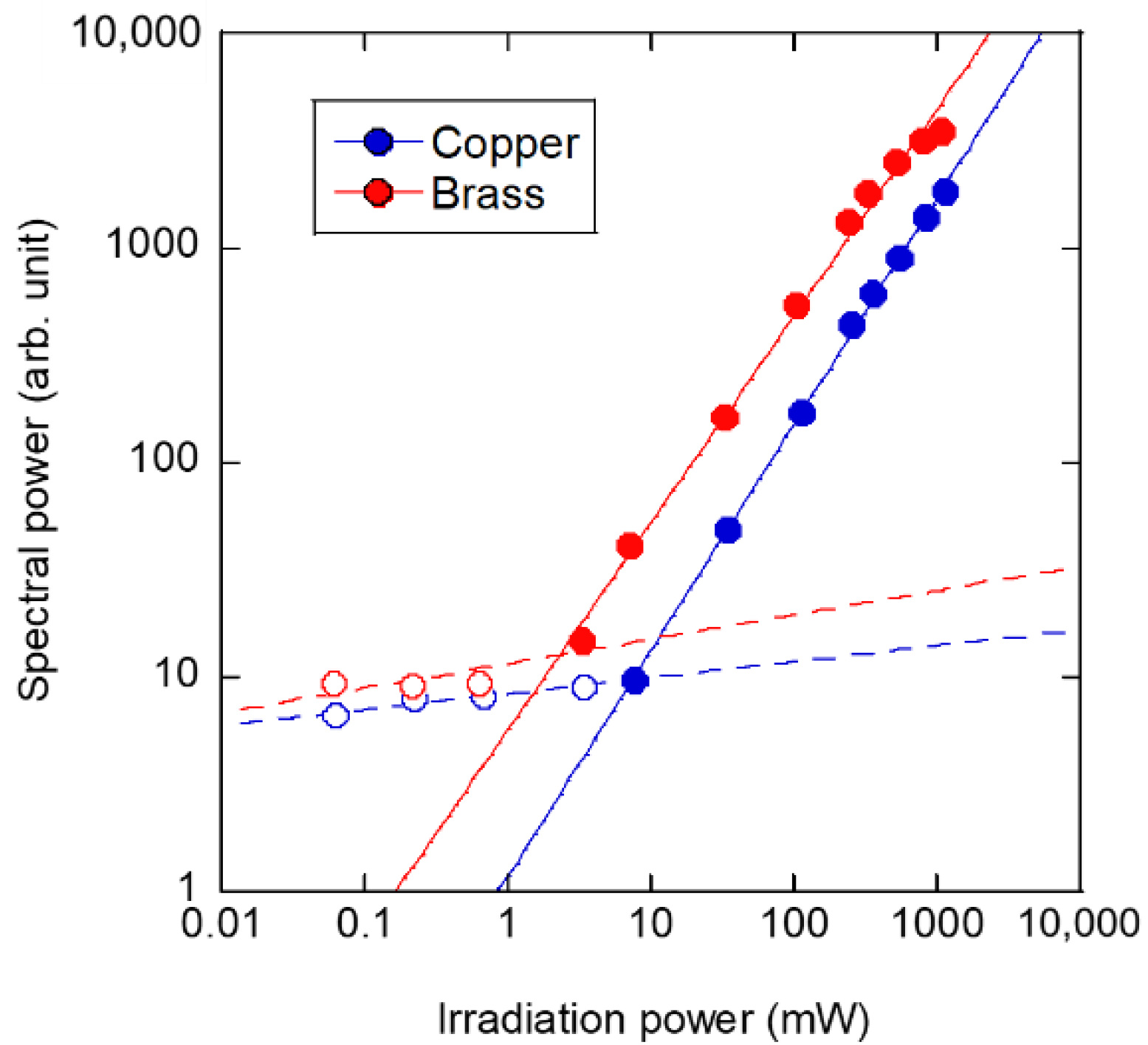Sweep Pulse Excitation Method for Enhancing Photoacoustic Elastic Waves at Different Laser Irradiation Parameters
Abstract
:1. Introduction
2. Materials and Methods
3. Distinctions of Sweep Pulse Excitation
4. Results of Dependence Evaluations and Discussion
4.1. Pulse-Width Dependence
4.2. Spot-Size Dependence
4.3. Irradiation Power Dependence
5. Conclusions
Author Contributions
Funding
Institutional Review Board Statement
Informed Consent Statement
Data Availability Statement
Conflicts of Interest
References
- Yashiro, S.; Takatsubo, J.; Miyauchi, H.; Toyama, N. A novel technique for visualizing ultrasonic waves in general solid media by pulsed laser scan. NDT E Int. 2008, 41, 137–144. [Google Scholar] [CrossRef]
- Maslov, K.; Zhang, H.F.; Hu, S.; Wang, L.V. Optical-resolution photoacoustic microscopy for in vivo imaging of single capillaries. Opt Lett. 2008, 33, 929–931. [Google Scholar] [CrossRef] [PubMed]
- Wang, Y.; Hu, S.; Maslov, K.; Zhang, Y.; Xia, Y.; Wang, L.V. In vivo integrated photoacoustic and confocal microscopy of hemoglobin oxygen saturation and oxygen partial pressure. Opt Lett. 2011, 36, 1029–1031. [Google Scholar] [CrossRef] [PubMed] [Green Version]
- Guo, Z.; Favazza, C.; Garcia-Uribe, A.; Wang, L.V. Quantitative photoacoustic microscopy of optical absorption coefficients from acoustic spectra in the optical diffusive regime. J. Biomed. Opt. 2012, 17, 066011. [Google Scholar] [CrossRef]
- Morisaku, T.; Yui, H. Laser-induced surface deformation microscope for the study of the dynamic viscoelasticity of plasma membrane in a living cell. Analyst 2018, 143, 2397–2404. [Google Scholar] [CrossRef]
- Mikami, K.; Hasegawa, N.; Okada, H.; Kondo, S.; Nishikino, M.; Kawachi, T. Flash-lamp-pumped 4 J, 50 Hz Nd:YAG nanosecond laser system for mobile and transportable equipment. Jpn. J. Appl. Phys. 2017, 56, 082701. [Google Scholar] [CrossRef]
- Kurahashi, S.; Mikami, K.; Kitamura, T.; Hasegawa, N.; Okada, H.; Kondo, S.; Nishikino, M.; Kawachi, T.; Shimada, Y. Demonstration of 25-Hz-inspection-speed laser remote sensing for internal concrete defects. J. Appl. Remote Sens. 2018, 12, 15009. [Google Scholar] [CrossRef] [Green Version]
- Huda, F.; Kajiwara, I.; Hosoya, N.; Kawamura, S. Bolt loosening analysis and diagnosis by non-contact laser excitation vibration tests. Mech. Syst. Signal Process. 2013, 40, 589–604. [Google Scholar] [CrossRef]
- Kajiwara, I.; Hosoya, N. Vibration testing based on impulse response excited by laser ablation. J. Sound Vib. 2011, 330, 5045–5057. [Google Scholar] [CrossRef] [Green Version]
- Hosoya, N.; Kajiwara, I.; Umenai, K.; Maeda, S. Dynamic characterizations of underwater structures using noncontact vibration tests based on nanosecond laser ablation in water: Evaluation of passive vibration suppression with damping materials. J. Vib. Control 2018, 24, 3714–3725. [Google Scholar] [CrossRef]
- Kikuchi, S.; Mikami, K.; Nakashima, D.; Kitamura, T.; Hasegawa, N.; Nishikino, M.; Kanaji, A.; Nakamura, M.; Nagura, T. Laser resonance frequency analysis: A novel measurement approach to evaluate acetabular cup stability during surgery. Sensors 2019, 19, 4876. [Google Scholar] [CrossRef] [PubMed] [Green Version]
- Mikami, K.; Nakashima, D.; Kikuchi, S.; Kitamura, T.; Hasegawa, N.; Nagura, T.; Nishikino, M. Stability diagnosis of orthopedic implants based on resonance frequency analysis with fiber transmission of nanosecond laser pulse and acceleration sensor. Proc. SPIE 2020, 112330, 112330O. [Google Scholar] [CrossRef]
- Nakashima, D.; Mikami, K.; Kikuchi, S.; Nishikino, M.; Kitamura, T.; Hasegawa, N.; Matsumoto, M.; Nakamura, M.; Nagura, T. Laser resonance frequency analysis of pedicle screw stability: A cadaveric model bone study. J. Orthop. Res. 2021, 39, 2474–2784. [Google Scholar] [CrossRef] [PubMed]
- Mikami, K.; Nemoto, M.; Nagura, T.; Nakamura, M.; Matsumoto, M.; Nakashima, D. Machine learning-based diagnosis in laser resonance frequency analysis for implant stability of orthopedic pedicle screws. Sensors 2021, 21, 7553. [Google Scholar] [CrossRef] [PubMed]
- Meredith, N.; Alleyne, D.; Cawley, P. Quantitative determination of the stability of the implant-tissue interface using resonance frequency analysis. Clin. Oral Implants Res. 1996, 7, 261–267. [Google Scholar] [CrossRef]
- Debruyne, S.; Grognard, N.; Verleye, G.; Massenhove, K.V.; Mavreas, D.; Vannet, B.V. ISQ calculation evaluation of in vitro laser scanning vibrometry-captured resonance frequency. Int. J. Impl. Dent. 2017, 3, 44. [Google Scholar] [CrossRef] [Green Version]
- Nakashima, D.; Ishii, K.; Matsumoto, M.; Nakamura, M.; Nagura, T. A study on the use of the Osstell apparatus to evaluate pedicle screw stability: An in-vitro study using micro-CT. PLoS ONE 2018, 13, e0199362. [Google Scholar] [CrossRef]
- Hosoya, N.; Kajiwara, I.; Hosokawa, T. Vibration testing based on impulse response excited by pulsed-laser ablation: Measurement of frequency response function with detection-free input. J. Sound Vib. 2012, 331, 1355–1365. [Google Scholar] [CrossRef]
- Mikami, K.; Hasegawa, N.; Kitamura, T.; Okada, H.; Kondo, S.; Nishikino, M. Characterization of laser-induced vibration on concrete surface toward highly efficient laser remote sensing. Jpn. J. Appl Phys. 2020, 59, 076502. [Google Scholar] [CrossRef]
- Mikami, K.; Zhao, Y.; Morita, M.; Sakamoto, T.; Nishikawa, H. Highly sensitive low-energy laser sensing based on sweep pulse excitation for bolt loosening diagnosis. J. Nondestruct. Eval. 2021, 40, 12. [Google Scholar] [CrossRef]
- Bergström, D.; Powell, J.; Kaplan, A.F.H. Absorptance of nonferrous alloys to Nd:YLF and Nd:YAG laser light at room temperature. Appl. Opt. 2007, 46, 1290–1301. [Google Scholar] [CrossRef] [PubMed] [Green Version]
- Stuart, B.C.; Feit, M.D.; Rubenchik, A.M.; Shore, B.W.; Perry, M.D. Laser-induced damage in dielectrics with nanosecond to subpicosecond pulses. Phys. Rev. Lett. 1995, 74, 2248–2251. [Google Scholar] [CrossRef] [PubMed] [Green Version]
- Mero, M.; Rudolph, W.; Ristau, D.; Starke, K. Scaling laws of femtosecond laser pulse induced breakdown in oxide films. Phys. Rev. B 2005, 71, 115109. [Google Scholar] [CrossRef]








| Property | Copper | Brass | |
|---|---|---|---|
| Thermal conductivity | (W/mK) | 386 | 106 |
| Specific heat | (J/kgK) | 419 | 386 |
| Thermal expansion coefficient | (/K) | 17.7 × 10−6 | 20.8 × 10−6 |
| Density | (kg/m3) | 8960 | 8400 |
| Young’s modulus | (GPa) | 130 | 106 |
| Poisson ratio | 0.34 | 0.35 | |
| Absorption at 1053 nm [21] | (%) | 6 | 12 |
Publisher’s Note: MDPI stays neutral with regard to jurisdictional claims in published maps and institutional affiliations. |
© 2022 by the authors. Licensee MDPI, Basel, Switzerland. This article is an open access article distributed under the terms and conditions of the Creative Commons Attribution (CC BY) license (https://creativecommons.org/licenses/by/4.0/).
Share and Cite
Mikami, K.; Sudo, N.; Okamoto, Y.; Nagura, T.; Nakashima, D. Sweep Pulse Excitation Method for Enhancing Photoacoustic Elastic Waves at Different Laser Irradiation Parameters. Sensors 2022, 22, 5025. https://doi.org/10.3390/s22135025
Mikami K, Sudo N, Okamoto Y, Nagura T, Nakashima D. Sweep Pulse Excitation Method for Enhancing Photoacoustic Elastic Waves at Different Laser Irradiation Parameters. Sensors. 2022; 22(13):5025. https://doi.org/10.3390/s22135025
Chicago/Turabian StyleMikami, Katsuhiro, Natsumi Sudo, Yuka Okamoto, Takeo Nagura, and Daisuke Nakashima. 2022. "Sweep Pulse Excitation Method for Enhancing Photoacoustic Elastic Waves at Different Laser Irradiation Parameters" Sensors 22, no. 13: 5025. https://doi.org/10.3390/s22135025
APA StyleMikami, K., Sudo, N., Okamoto, Y., Nagura, T., & Nakashima, D. (2022). Sweep Pulse Excitation Method for Enhancing Photoacoustic Elastic Waves at Different Laser Irradiation Parameters. Sensors, 22(13), 5025. https://doi.org/10.3390/s22135025






